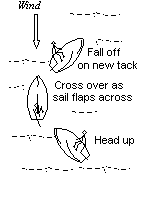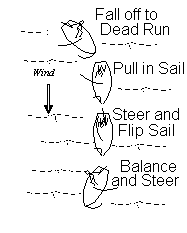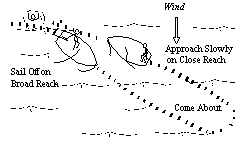![]()
Introductory Handbook
for Sailing Boats
SAILING THE LIDO
The maneuvers described below--leaving the dock, coming about, jibing, sailing in small circles, sailing backwards, righting after a capsize, anchoring, and docking--involve skills that are absolutely necessary to safely handle a small boat. For this reason, they are included in a Junior Skipper sailing test.
The maneuvers can be done in different ways, and not all the possible ways to do them are described below. Also described below are how to deal with groundings (getting stuck in the mud) and equipment failures on the water.
Leaving the Dock
Before leaving the dock, check the boat over carefully (all hull drain plugs in place? everyone's lifejacket on?) and make sure the mainsheet is not caught around the rudder. If it's caught, take off the rudder to free the mainsheet.
Before casting off, check for boats or windsurfers approaching the dock.
Coming About
 To come about, you gently push the tiller into the sail, and the boat heads up from the old tack and then falls off onto the new tack as
it continues to turn.
To come about, you gently push the tiller into the sail, and the boat heads up from the old tack and then falls off onto the new tack as
it continues to turn.
You should cross from one side to the other as the boom comes across, so your weight is ready to balance the boat on the new tack. To avoid a capsize, uncleat the
mainsheet as soon as the sail luffs. You'll have more room to get across if you lift the tiller up.
You can cross either facing backwards or facing forwards. In either case, you will be passing the tiller from one hand to the other, and also changing the hand you use for the mainsheet. You can let go of the mainsheet, but don't drop the tiller. Facing backwards makes it easier to pass the tiller from one hand to another, although facing forwards lets you watch where you're going.
If you are hiked out (sitting out on the rail above the seat to balance the boat in strong wind) before the come about, fold the hiking stick as you come into the boat, and hold both the hiking stick and tiller together as you cross. When you get up on the rail on the other side, you can unfold the hiking stick again.
Always check with your crew before coming about. Call out "Ready about?" and wait for their "Ready" signal before beginning; then call out "Helm's a-lee!" or "Coming About!" as you actually head up.
Also, be sure to check for windsurfers or other boats that may collide with you when you come about.
The crew should release the jib when it starts to luff, and let the wind carry it across to the other side, then bring the jib in when it starts to fill on the other tack.
Heaving To
Heaving to is used to stabilize the boat for offshore picnics, changing drivers out on the water, or bailing out the boat. It is done like a come about, but the jib is left in place while letting the mainsail out completely and gradually swinging the tiller to the leeward (downwind) side of the boat as you slow down.
Heaving to can also be used to allow a person fallen overboard to swim back to the boat. If done immediately, heaving to keeps the boat fairly close.
Jibing
 To jibe safely, you bring the mainsail in when the boat is on a run, then turn slightly so the wind catches its other side, and let it swing out onto the other side of the
boat. By manually bringing the sail partway across, you prevent its sweeping violently across the boat and possibly injuring someone who may be standing up.
To jibe safely, you bring the mainsail in when the boat is on a run, then turn slightly so the wind catches its other side, and let it swing out onto the other side of the
boat. By manually bringing the sail partway across, you prevent its sweeping violently across the boat and possibly injuring someone who may be standing up.
You must be ready to use your weight and steering to prevent a capsize. The boat must be balanced with the mast straight upright, or it may turn unintentionally. After the jibe, you may have to hike out and pull hard on the tiller to prevent a spinout and tipover capsize.
You can jibe facing backward or forward. If facing backward, you pull in the sail using the mainsheet near the transom, while facing forward you use the mainsheet near the cleat. Whichever way you face, you should not be handling the mainsheet overhead or behind your back, where you could get entangled.
Never start a jibe without warning the crew, since they could get their skull cracked by the boom swinging across, or their nose skinned by the boom vang. You should also remember to stay low during the jibe, lest the boom tell you how it got its name. Call out prepare to jibe before starting a jibe, and jibe ho (or DUCK!!) as the boom starts to cross.
Before jibing, you must fall off (tiller away from the sail) toward a dead run. While on a broad reach, your weight may be needed to balance the boat, but as soon as you reach a run, you may need to move to the center of the boat.
Always move to the center of the boat or the same side as the sail before jibing. If you are in the center of the boat, be prepared to move quickly to balance the boat after the jibe.
Once the boat is on a run, your body should be between the tiller and the sail. The tiller can be rested against your hip, butt, or leg (depending on which way you're facing), so you can steer by pushing on the tiller. Both hands are then freed to pull in the mainsheet. When the boom is in over the boat, grab the tiller and steer to cause the jibe (tiller away from the sail), while holding the mainsheet with the other hand. Don't let go of the tiller!
You can tell when the jibe is about to happen because the mainsheet goes slack.
In heavy wind and waves, try to pull in the boom just as a wave passes underneath the boat, and jibe just as the next wave passes underneath. When the boat is moving fastest, the force on the sail is least.
Circles Around a Buoy
 Sailing in a small circle around a buoy requires that you come about and jibe quickly, just as you may need to do to avoid collisions.
Sailing in a small circle around a buoy requires that you come about and jibe quickly, just as you may need to do to avoid collisions.
The figure shows the steps involved in sailing a small circle. The come about and jibe occur when the buoy, as seen from the boat, is 90 degrees away from the wind direction. The circle has a corner because you have to hold a close hauled course before and after coming about.
Steering While Drifting Backwards
Steering while the Lido drifts backwards is required to leave a crowded dock, and can be useful to recover control if you stop while coming about. As mentioned before, it's difficult to steer while drifting backwards if the centerboard is not fully down.
When the boat is drifting backwards, the tiller works the opposite way compared to when the boat is sailing forwards. If you move the tiller to port, the bow moves to port.
To practice steering while drifting backward, head up until the boat is in irons. Let it coast to a stop while in irons. The bubbles in the water alongside the boat will indicate when you start to drift backwards.
When you start going backwards, steer to keep the boom over the middle of the boat. You have to keep the sails from filling, which would cause the boat to sail forward.
If the boom swings to one side, swing the tiller toward the opposite side, so that the rudder will push the stern back underneath the boom. At first, you will have to hold the tiller hard over to get any effect, but as the boat drifts faster less tiller movement will be necessary. If you face backwards, you will find that the line of the tiller will indicate the direction the stern will take as the boat drifts backwards.
Man Overboard Drill
 When a person falls off a boat, the most important thing to do immediately is to keep them in sight so you don't lose them. Assign someone to watch them.
When a person falls off a boat, the most important thing to do immediately is to keep them in sight so you don't lose them. Assign someone to watch them.
The next most important thing is to return and pick them up safely, going slowly enough that they can be brought into the boat.
The man overboard drill (the man overboard is two plastic jugs tied together) tests these skills, as well as the skills for docking safely. The drill requires sailing slowly with good control, which is the right way to dock a boat.
To go slowly with good control, a boat must be on a close reach with the sails partly luffing.
The figure shows the recommended method for the man overboard drill. After assigning someone to watch the man overboard, sail away on a broad reach, so that you will return on a close reach. Check that you're on a close reach by seeing if the mainsheet will droop to the water when released. Tell the crew to release the jib when you're within about 20 feet from the man overboard.
As you approach, keep the boat pointed at the man overboard, or a little upwind to compensate for sideslip from wind and waves. The boat should come to a near stop with the man overboard on the upwind side.
Avoiding Capsizes, Righting After a Capsize
Capsizes can almost always be prevented. If the boat starts to tip over, let the sheets out (fastest response), hike out, or head up into the wind.
Always keep the mainsheet handy so you can immediately release it if the boat heels suddenly in a gust.
Always be ready to move your weight suddenly if necessary, and scramble for the high side if the boat heels suddenly.
Never sail with the boat heeled over so far that it's only an inch or two away from taking on water That not only puts you closer to a capsize but also slows you down. Head up a little and let the sails luff more.
If you do capsize, keep calm and plan your actions so you'll be back sailing more quickly. Never swim away from the boat or cling to the high side of a capsized boat.
First check that everyone is OK. Crew should float alongside the boat, holding onto the bow painter to keep the bow pointing into the wind. Don't leave the boat to swim after any paddles or clothing.
Next make sure all the sheets are uncleated. In high winds and big waves, righting will be easy if you loosen the outhaul and unclip it from the mainsail's clew.
In strong wind, it's also best to point the bow into the wind by holding onto the bow for a few seconds while the wind pushes the hull downwind. This is the best place for your crew to be while you're righting the boat.
In light winds, your crew can float between the hull and the boom, holding onto the centerboard case lightly. As you right the boat, they'll come up inside the hull.
 To right the Lido, stand on the centerboard and pull on the hull to tip it back up. You should pull the jib sheet, making sure that it is uncleated and that you are
pulling against the knotted end, not the end attached to the jib. Lean back for more leverage. It may take a few seconds before your weight can break the sails free of
the water.
To right the Lido, stand on the centerboard and pull on the hull to tip it back up. You should pull the jib sheet, making sure that it is uncleated and that you are
pulling against the knotted end, not the end attached to the jib. Lean back for more leverage. It may take a few seconds before your weight can break the sails free of
the water.
Don't jump up and down on the centerboard; it will break it. It's okay to push down with one foot near the middle of the centerboard, but the other foot should be placed firmly against both the hull and centerboard, parallel to the centerboard slot.
Anchoring
The anchor should always be tied to the bow and ready for use. Anchor if you capsize near the rocks, if the boat breaks and you can't sail back to the dock, or if you need to reef the mainsail while away from the dock.
The anchor should be let out carefully so as not to get the anchor line wrapped around the mast, jib sheets, or shroud, or snarled in its line or in the bow painter. Thread the anchor under the jib sheet, and out between the mast and shroud along its line to the bow.
Docking
Always approach the leeward (downwind) side of the dock on a close reach, so that you can control the boat's speed and direction.
Start your approach from a point well downwind of the dock, so that you have plenty of room. Note the wind direction and strength at the dock, and check carefully for boats or windsurfers that may be leaving the dock.
 Let the crew know that they'll have to go forward to tie the boat up. If you're alone, get someone on the dock to catch your boat, come in alongside another docked boat
and grasp it, or run forward yourself as the boat reaches the dock
Let the crew know that they'll have to go forward to tie the boat up. If you're alone, get someone on the dock to catch your boat, come in alongside another docked boat
and grasp it, or run forward yourself as the boat reaches the dock
If you have a problem docking or leaving the dock, never try to jibe the boat next to the seawall. Instead, head the boat up toward the dock, even if this means drifting gently onto other boats.
In Case of Grounding
The Lidos need 3-1/2 feet of water to sail in with their centerboards down. If you go aground, raise the centerboard halfway to get away. Don't raise the centerboard all the way unless you can get away by sailing downwind, because you need some centerboard to sail on a close reach or beam reach.
If the centerboard uphaul line is very difficult to pull, don't force it, as it may break off. Instead, try to point the boat into the wind and get it to move forward, even if this means getting out and standing in the muck.
In very shallow water and very light wind, raise the centerboard all the way, take off the rudder, and use the paddle to steer. Don't try this in strong wind or if there's a risk of going on the rocks; anchor instead and signal for a tow.
Equipment Failure
If any club equipment breaks while you are sailing, return to the dock immediately and fix it as soon as possible.
If you can't sail back, anchor and signal for a tow. The distress signal consists of standing up and waving your arms up and down at your sides.
To get a tow from the rescue skiff, you should tie the bow painter to the skiff's tow line with bowline knots. Raise your centerboard before being towed.





